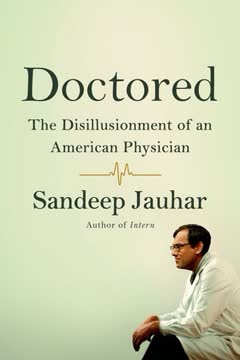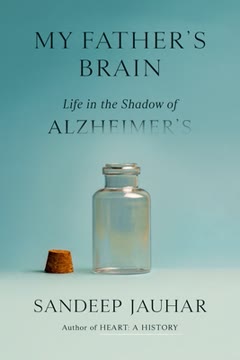Key Takeaways
1. Medicine's Midlife Crisis: A Profession in Decline
Today medicine is just another profession, and doctors have become like everybody else: insecure, discontented, and anxious about the future.
Lost ideals. The author, a cardiologist, reflects on his career at midlife, realizing he has become the kind of doctor he never intended: impatient, indifferent, and paternalistic. This personal disillusionment mirrors a broader crisis within American medicine, where physicians increasingly express diminished enthusiasm for their profession. Once revered as community pillars, doctors now feel like ordinary professionals, struggling with the loss of their ideals and a nagging sense that their lives are half over.
Declining morale. Surveys reveal a stark decline in physician morale, with only 6% describing it as positive in 2008. Many doctors would discourage friends or family from entering medicine, citing decreasing incomes, excessive paperwork, and insufficient time with patients. This collective malaise stems from a perception that the noble calling has devolved into merely "a job," leaving many to question the sacrifices made for their careers.
Historical shift. The mid-20th century saw doctors as "knights"—highly respected, well-compensated, and autonomous. This "golden age" of medicine, marked by scientific triumphs and increasing life expectancy, allowed physicians to set their own hours and fees. However, the introduction of Medicare in 1965, while increasing access to care, inadvertently led to perceptions of doctors as "knaves" bilking the system, setting the stage for the managed care era and the subsequent erosion of professional status.
2. The Commercialization of Care: From Knights to Knaves
The temptation to get rich while the getting’s good is powerful.
Profit motive. The shift from doctors as "knights" (virtuous, patient-focused) to "knaves" (selfish, profit-driven) began as health care spending outpaced economic growth, fueled by the fee-for-service model. Reports of unnecessary operations and rampant fraud led to public distrust and the rise of managed care organizations (HMOs) in the 1970s, which aimed to control costs through price controls and fixed payments. This fundamentally altered the financial landscape for physicians.
Managed care impact. Managed care, while initially slowing health expenditure growth, significantly reduced physician autonomy and income. Doctors, now seen as "pawns" ruled by external regulations, faced increasing pressure to see more patients and perform more procedures to maintain their earnings. This commercialization led to a decline in job satisfaction, with many physicians feeling like cogs in a money-making machine rather than independent healers.
Financial incentives. The author's own experience with pharmaceutical companies, giving paid talks for the drug Natrecor, highlights the pervasive influence of financial incentives. Despite initial ethical qualms, the need for supplemental income—due to academic salaries being lower than private practice—led him to participate. This entanglement with industry, where even the appearance of bias can damage trust, underscores the ethical compromises doctors face in a commercialized system.
3. Overutilization: The Cost of Defensive and Profit-Driven Medicine
In our health care system, if you have a slew of physicians and a willing patient, almost any sort of terrible excess can occur.
Wasteful spending. Overutilization of health care services, estimated to cost hundreds of billions annually, is a major driver of the nation's $2.5 trillion health expenditure. This waste stems from:
- Defensive medicine to avoid lawsuits (e.g., ordering unnecessary tests)
- Reluctance to accept diagnostic uncertainty
- Lack of consensus on effective treatments
- Belief that newer, more expensive technology is always better
Supply-sensitive care. Research from the Dartmouth Atlas of Health Care demonstrates that regions with more doctors and health services exhibit higher per capita utilization, without necessarily improving patient outcomes. For example, Medicare beneficiaries in high-spending regions often see numerous physicians and undergo excessive tests in their final months of life, leading to higher costs and potentially worse outcomes. This "supply-sensitive care" highlights how the availability of services can induce demand.
Perverse incentives. The fee-for-service model, where doctors are paid for each service, incentivizes quantity over quality. As reimbursement rates decline, physicians often increase the volume of services to maintain income. This leads to practices like:
- "Friendly" consults between specialists to generate referrals
- Performing numerous tests (e.g., stress tests, echos) even when not clinically indicated
- Billing for minor medication adjustments or diagnostic workups that could be done outpatient
This system creates a "moral hazard," where both patients (with low deductibles) and providers (with financial incentives) are less concerned about costs.
4. Ethical Crossroads: Navigating Patient Autonomy and Physician Conscience
Patients’ decisions about their care must be paramount, as long as those decisions are in keeping with ethical practice and do not lead to demands for inappropriate care.
Conflicting principles. The author grapples with the tension between patient autonomy and a physician's professional judgment, particularly in cases involving end-of-life care or refusal of recommended treatments. While patient self-determination is a prevailing ethic, doctors often limit it when requests clash with medical best practices or moral convictions. This was evident in the author's wife's pregnancy, where an anesthesiologist refused a preferred surgical procedure due to perceived safety concerns, and in cases where patients refused necessary diagnostic tests.
Futility and conscientious objection. The concept of "medical futility" often allows doctors to withhold treatments deemed ineffective, as the author attempted with a brain-damaged patient. However, the line between professional integrity and paternalism can be blurry. The author's experience with James Irey, whom he convinced to undergo a catheterization that led to his death, underscored the profound impact of a doctor's words and the responsibility to wield influence wisely and sparingly.
Double effect doctrine. In end-of-life care, the "double effect" principle, derived from Catholic ethics, allows actions (like administering morphine) that relieve suffering even if they hasten death, provided the primary intention is symptom relief and death is an unintended side effect. This doctrine offers a framework for navigating complex ethical dilemmas, but it also raises questions about how to apply it when a patient is not actively suffering, as in the case of Rose Crespo, who requested assistance in dying.
5. The Perils of Deception: When Doctors and Patients Lie
We don’t want to admit that we are fundamentally dishonest about reality, that we do not really control our own lives.
Mutual deception. The doctor-patient relationship, ideally founded on trust, is often marred by deception from both sides. Patients may malinger, feign illness (factitious disorder/Munchausen syndrome), or withhold crucial information (like immigration status or lifestyle choices) to achieve specific outcomes, such as obtaining drugs or avoiding deportation. The author's encounters with Ellie McGlone, who fabricated a complex medical history, and Juana Morales, an undocumented immigrant needing a heart transplant, illustrate these challenges.
Physician's role. Physicians also engage in deception, sometimes by omission (not fully disclosing mistakes), by commission (ordering unnecessary tests), or by promoting therapies with limited evidence. The author admits to practicing a "sort of ethics of double effect," rationalizing his participation in overtesting at Chaudhry's office as a means to support his family, despite the downstream consequences of false positives and radiation exposure. This self-deception allows doctors to cope with the moral compromises inherent in a commercialized system.
The "vital lie." Ernest Becker's concept of the "vital lie" suggests that humans erect defenses to cope with the deepest fears of powerlessness, loss, and death. In medicine, this translates to denying systemic sickness, overworking for knightly and knavish reasons, and clinging to the notion of control. The author's aggressive, ultimately futile, interventions for Lily Dunhill, a dying patient, highlight how a doctor's fear of failure or grief can lead to treating a person as an "experiment," further perpetuating deception.
6. Burnout and Disillusionment: The Personal Toll on Physicians
Burnout is associated with excessive workload, difficulty balancing one’s personal and professional lives, and loss of work control, autonomy, and meaning.
Widespread malaise. The relentless commercialization and systemic pressures in medicine have led to widespread burnout among physicians. Characterized by emotional exhaustion, depersonalization, and a reduced sense of personal accomplishment, burnout is a significant problem, with approximately a third of doctors admitting to its signs. This erosion of the soul is fueled by excessive workload, the struggle to balance personal and professional lives, and a profound loss of autonomy and meaning in their work.
Personal impact. The author's own experience reflects this burnout, marked by a "subterranean depression," chronic edginess, and angry outbursts. The constant financial stress, the guilt of not spending enough time with family, and the moral compromises of moonlighting left him feeling "checked out" and questioning his choices. This personal toll underscores how the systemic issues in medicine directly impact the mental and emotional well-being of its practitioners.
Loss of control. Doctors often feel like "pawns" in a game played by regulators and insurers, forced to follow "cookbook medicine" rather than exercise their professional judgment. This loss of control over their professional destiny, coupled with the perception that things are unlikely to improve, contributes to a sense of hopelessness and "operatic self-pity." The author's father's pragmatic advice—"worry the whole night if you want to, but in the morning go to work and do your job"—highlights a generational difference in coping with professional adversity.
7. Finding Meaning Amidst the Chaos: The Path to Professional Salvation
The challenge in dealing with physician burnout on a practical level is to create new incentive schemes to foster that meaning.
Redefining success. To combat burnout, physicians must redefine success beyond income, embracing measures like patient attachments, making a difference, and providing good care while managing resources responsibly. The key lies in finding meaning in one's work, which requires identifying core values and fighting for them. This internal compass is crucial for navigating the changing landscape of the profession.
Focus on the craft. The author's renewed commitment to his heart failure program—implementing best practices, streamlining care, increasing hospice use—reflects a return to the noble craft of medicine. This focus on what is within a doctor's control, particularly the human moments and patient relationships, offers a path to professional salvation. It's about absorbing oneself in everyday pursuits that align with one's deepest values.
Resilience and adaptability. Medicine demands immense resilience from its providers, who are constantly stretched and bent by external stresses. The author's journey, from disillusionment to a more settled life in the suburbs, illustrates the need for adaptability. While external circumstances may force compromises, maintaining an internal equilibrium and focusing on the intrinsic rewards of patient care can help mitigate the pervasive anxiety and despair.
8. The Power of Human Connection: Reclaiming the Doctor-Patient Bond
The human moments are what others—the lawyers, the bankers—envy about our profession, and no company, no agency, no entity can take those away.
Intrinsic reward. Despite the commercial pressures, the most satisfying aspect of medicine for most physicians remains the direct care of patients and the human connections forged. These "human moments"—like the house call to Hyman Gesselman, a dying patient—offer a profound sense of purpose that transcends financial incentives or administrative burdens. They are the unique, irreplaceable core of the profession.
Erosion of connection. The hurried pace of modern medicine, driven by increased patient volume and administrative tasks, erodes the doctor-patient bond. Doctors rush through visits, interrupt patients, and rely on technology over physical examination, leading to a lack of empathy and missed nuances in care. This depersonalization contributes to patient dissatisfaction and a feeling of being a "baton" in a relay race of consultants.
Rebuilding trust. Reclaiming the doctor-patient bond requires prioritizing time and genuine interaction. Educating patients, ensuring timely follow-ups, and improving communication during transitions of care are crucial steps. The author's realization that "the system makes us bad" underscores the need for systemic changes that allow doctors to practice with the humanity and attention that patients deserve and that initially drew many to the profession.
9. Systemic Flaws: Misaligned Incentives Drive Waste and Dysfunction
As is so often the case in our health care system, doctors’ incentives do not serve broader social goals.
Incentive misalignment. The fundamental flaw in the American health care system is the misalignment of incentives. Hospitals, paid a fixed amount per admission, want shorter patient stays, while doctors, paid per visit, benefit from longer stays. This conflict leads to inefficiencies and waste. Current laws even prohibit hospitals from sharing savings with doctors for reducing services, hindering efforts to align goals.
P4P paradox. "Pay for performance" (P4P) initiatives, designed to reward quality care, often have unintended consequences. Forcing antibiotic administration within a strict timeframe for pneumonia, for example, can lead to overuse and antibiotic-resistant infections. Surgical report cards, while initially improving outcomes, also incentivized "cherry-picking" healthier patients, leaving sicker ones without necessary operations. These programs, while well-intentioned, often fail to account for the complexities of patient care and physician behavior.
The money trail. To understand physician behavior, one must "follow the money." The fee-for-service model, coupled with declining reimbursement rates, compels doctors to increase the quantity of services, often leading to overtesting and overconsultation. Reforms like bundled payments, accountable care organizations, and "appropriate-use criteria" aim to correct these perverse incentives, but without addressing the underlying financial pressures, doctors will continue to prioritize revenue generation, often at the expense of optimal patient care.
10. Personal Struggles Mirror Professional Challenges: A Doctor's Journey to Equilibrium
Character is destiny. There is only so much you can do to overcome the constraints of your biology.
Intertwined lives. The author's personal struggles—financial stress, marital conflict, the demands of fatherhood—are deeply intertwined with his professional challenges. His "midlife crisis" reflects the broader crisis in medicine, where the pursuit of ideals clashes with the realities of a commercialized system. The constant pressure to provide for his family, coupled with the guilt of compromising his professional values, creates a profound sense of unease and a search for equilibrium.
Accepting limitations. The author's journey involves confronting his own limitations and inherited traits, such as paranoia, brooding, and a tendency to blame others. While recognizing these patterns, he also acknowledges the difficulty of overcoming them, suggesting that "character is destiny." This acceptance, however, is not resignation but a realization that true change comes from within, by focusing on what can be controlled and finding meaning in the present.
The path forward. The decision to leave Manhattan for the suburbs, driven by financial necessity and a desire for more space, represents a significant adjustment. This move, initially met with trepidation, ultimately provides a sense of peace and predictability, allowing the author to refocus on his core values: family and the human aspects of medicine. It underscores that sometimes, external changes, even if reluctantly made, can facilitate internal shifts towards contentment and a renewed sense of purpose.
Last updated:
Review Summary
Doctored receives mixed reviews, with some praising its honesty and insights into the healthcare system, while others criticize the author's perceived complaining and entitlement. Readers appreciate Jauhar's candid discussion of issues like overtesting, financial pressures, and ethical dilemmas in medicine. However, many find his personal financial struggles unsympathetic given his privileged position. The book sparks debate about physician compensation, healthcare costs, and the challenges of practicing medicine in America today. Despite its flaws, some readers find it thought-provoking and illuminating.
Similar Books
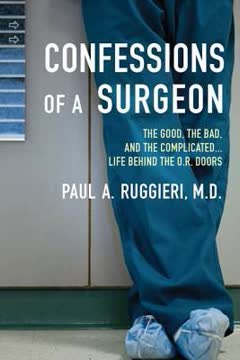
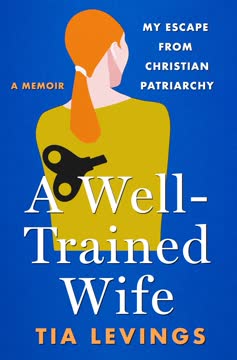


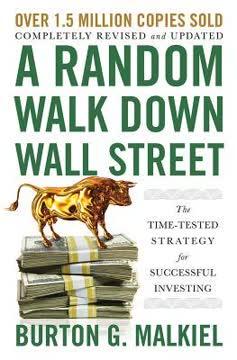
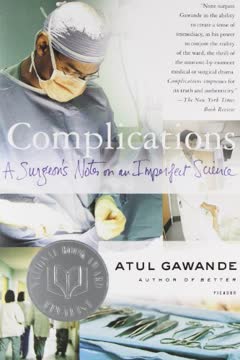
Download PDF
Download EPUB
.epub digital book format is ideal for reading ebooks on phones, tablets, and e-readers.
